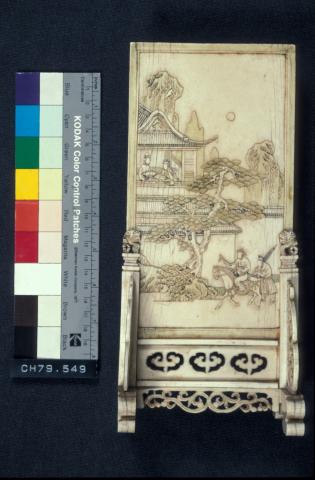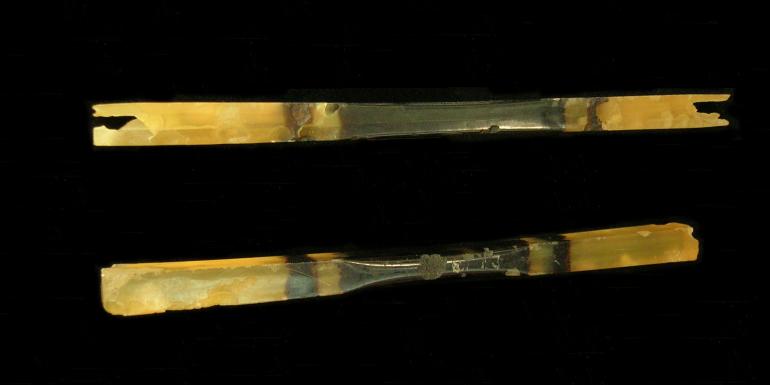Deterioration
Bone and ivory have directional properties (are anisotropic) and are therefore susceptible to warping and cracking on exposure to moisture and heat (Figure 4). This is especially so for thin artefacts where even moisture from the hands may be damaging. Warping and cracking are essentially irreversible. Bone and ivory are also prone to chemical attack and staining.
Deterioration processes which affect bone and ivory include:
- warping and cracking due to changes in relative humidity and temperature. Ivory is particularly sensitive to changes in relative humidity;
- chemical and bacterial degradation of the protein component of bone and ivory. This is enhanced by prolonged exposure to water and/or burial in aerobic sediments;
- attack on the inorganic components of these materials by acids. Artefacts that were previously buried in an acidic soil will usually be degraded and fragile;
- attack on the organic components by alkaline reagents. A soft and crumbly matrix is the result of substantial collagen loss;
- bleaching by direct sunlight and UV radiation. UV exposure will also cause weakening of the collagen matrix and yellowing of the natural oils found in ivory;
- damage by heat. When burnt these materials become grey or blue-black in colour;
- contact with sulphur-containing compounds (for example, some rubbers and certain paints), which will turn ivory an unnatural yellow-orange colour;
- staining due to contact with corroding metals such as copper and iron. The porous nature of these materials makes them very susceptible to staining.
Figure 4: 19th century Chinese ivory screen and stand showing cracking.
Ivory tends to develop an attractive yellow-brown patina as it ages. Do not attempt to remove this patina as it is part of its history, similar to the patina developed on a pewter tankard.
Horn, baleen and tortoise shell react in similar ways to those outlined above for bone and ivory. In addition, insect pests such as dermestids have a healthy appetite for keratin and can cause considerable damage to these materials (Figure 5). Avoid contact between water and thin films or delaminating surfaces of these materials as softening and deformation are likely to occur. As many tortoise shell objects are composites of smaller pieces ‘welded’ together with heat, moisture and pressure, they are particularly susceptible to damage in a fluctuating relative humidity environment.
Figure 5: A pair of Japanese hairpins (1900 – 1930s) in cow and buffalo horn (yellow and black respectively) showing several points of attack by dermestid beetles (copyright: Gordon Turner-Walker).
Cellulose nitrate, of which French ivory is composed, is an unstable chemical compound. As French ivory ages it develops a patina that is similar to that of ivory. Rather than being desirable, however, the development of this patina is an indication of the first stage of the potentially hazardous degradation of this material (see the chapter Modern Organic Materials). Loss of plasticizers from the cellulose nitrate (identifiable as weeping from the surface) may cause cracking and crazing of the object. As thin films of cellulose nitrate have been known to combust spontaneously, isolate deteriorating artefacts from other materials.














